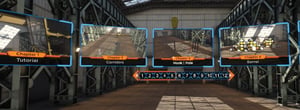This article originally appeared on the CONEXPO CON/AGG News page and includes an exclusive interview with Andrew Kauser, ITI’s Chief Product Officer and Senior Vice President of Simulated and Online Learning.
Virtual reality (VR) and augmented reality (AR) can play an influential role in a construction company’s operation, including safety training.
The National Safety Council (NSC) agrees. The NSC has developed a program called Work to Zero. The goal is to eliminate workplace fatalities by 2050 through the adoption of emerging technologies. AR/VR is among the six technologies recommended by the NSC to reduce accidents in the construction industry.

There are several proven benefits of VR/AR safety training, including:
- people learn better when actively engaged
- people can be trained to competency “out of harm’s way”
- larger groups can train together, even when located in different places.
“Technology is making it easier to provide experiences that are otherwise hard to replicate,” says Andrew Kauser, Chief Product Officer & Senior Vice President of VR and Online Learning at Industrial Training International (ITI). “With VR especially, you can create an entirely simulated environment. You can put people into a virtual experience they are likely to encounter in the real world, such as operating a crane when the wind kicks up. They can learn how to react to that kind of situation but in a safe way.”
Difference between VR and AR
VR is a completely digital experience. The user might wear a VR headset, operate an equipment simulator or even just train on a computer.
AR is when digital adds to (augments) real life. With AR, the user may use their mobile device, a headset or maybe a specialized pair of glasses to overlay video, graphics or sounds to what they are actually looking at.
Kauser says AR is a good fit as a job aid on an actual job site. For instance, a worker could view information to help repair a piece of equipment, perform a safety check or handle hazardous material. AR also has applicability from a safety training standpoint. “For example, you could project a 3D image of a piece of rigging equipment that the employee could interact with,” Kauser says.
VR is even more applicable for safety training, according to Kauser. “With the ability to practice and reinforce through VR, people are much more likely to act appropriately in the real world.”
From fall protection to heavy equipment operation
Simulated equipment operation is one way VR training is used in construction. VR is also used for other areas of safety training. For example, ITI offers VR training on topics like lockout/tagout, overhead crane inspections and hazard identification.
“Our hazard ID assessment training gives an individual the opportunity to virtually walk an entire construction site to practice identifying 10 common job site risks,” Kauser says. “The VR system determines how well the trainee did. This training also helps employees learn how to maintain job site organization, practice staging equipment and overall improve their jobsite orientation.”
Other VR providers offer training on topics like fall protection, first aid and fire extinguisher use. As VR adoption in the construction industry grows, there will likely be other safety topics that become available from the numerous VR training providers that are out there.
To help accelerate adoption, ITI plans to make its VR training more accessible. Some construction companies struggle with purchasing and maintaining a large inventory of VR headsets. “We’re looking to make some of our training available through a web browser,” Kauser says. “Simulated crane operation won’t be offered through a browser, though. That’s because of the high fidelity needed to provide the best experience for the user.”
CM Labs Simulations is another company that provides simulated crane training. The company also offers training for other lifting equipment like boom trucks, telehandlers and forklifts, along with a variety of earthmoving equipment including dozers, motor graders, excavators, backhoes, wheel loaders, compact track loaders and articulated dump trucks.
“One of our strengths is being able to offer all of those machines on one simulator,” says Alan Limoges, Strategic Relations Manager at CM Labs. That helps schools, unions and construction companies train as many people on as many pieces of equipment as possible — without having to buy excessive amounts of simulation equipment. “It takes less than a minute to switch from one training module to another,” Limoges says.
With equipment simulation training, you can use either headsets or displays (i.e., flat screens). When done correctly, the use of displays can provide an equally immersive experience. Furthermore, some would argue that the use of displays can provide an advantage.
Since VR can be hard on a person’s senses, some people can only train for short periods of time. “A lot of people actually get motion sickness from VR (headsets),” says Lisa Barbieri, Vice President of Marketing & Strategic Partnerships at CM Labs.
“Even people who are comfortable with VR will typically max out at 45 minutes to an hour,” Limoges says. The typical shift on a construction site is a lot longer than that. If the goal of simulated equipment training is to provide an immersive experience that replicates the real world as much as possible, one-hour training sessions might not cut it.
To further help mimic the real world, Barbieri says CM Labs leverages a physics-based core technology. That allows the training scenarios to be tailored to things like wind and soil. Next, mechanical engineers ensure that the simulators behave in a way that closely mimics real-life equipment. Finally, equipment experts make sure the overall training matches what is actually happening on construction job sites. “We have OEMs come in and validate the training, as well,” Barbieri adds.
One nice thing about simulation training is that the technology monitors how the trainee is doing. Objective feedback helps identify areas that may require additional training, which helps tailor training to the individual.
To that point, simulation training is useful for not only new operators but also experienced ones. Even an experienced operator can reinforce skills and practice working through challenging scenarios. Then that operator will be in a better position to handle those scenarios on an actual job site. That’s what ongoing safety training in general is all about, and VR/AR can play a role in making it happen.
Photo credits: CM Labs Simulations and Industrial Training International (ITI)
The ITI Virtual Reality Crane & Equipment Training suite has been developed in partnership with original equipment manufacturers to ensure an experience on par with operating the exact machinery each simulation was designed to replicate. With 9 different crane types and 1,000+ scenarios and virtual crane simulation courses offer the range of challenges needed to turn beginners into experts.
Interested in learning more about how ITI Simulations can help take your team's knowledge to the next level?
Visit: iti.com/vr and schedule a demo with one our our trained VR specialists.
About ITI
Industrial Training International (ITI) is a global leader in the design and delivery of learning solutions for organizations conducting crane, rigging, and load handling activities. Founded in 1986, the company originally specialized in instructor-led training, field services, and consulting. ITI has since grown to also produce live online, and on-demand courses delivered via the ITI Learning Hub and has been recognized with numerous industry association awards for its groundbreaking virtual reality crane and equipment simulations solution. For more information, visit: iti.com.






COMMENTS